Aggregates Sizer - Specs
Aggregation Analysis System for Biopharmaceuticals
System Configuration
The system configuration can be optimized to address various uses, purposes, measurement objects, environments and conditions
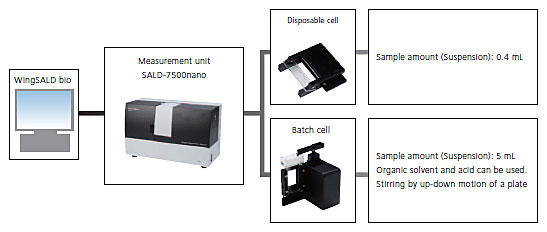
Measurement at the sample concentration of 0.1 ppm is possible.
Nano Particle Size Analyzer
SALD-7500nano
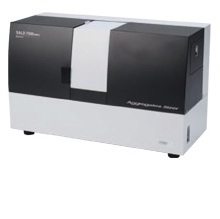
- Violet semiconductor laser (wavelength: 405 nm) is used for the semi-permanent light source. Maintenance, such as gas replacement, is unnecessary.
- The detector incorporates 78 elements at the front, one element at the side, and 5 elements at the back, for a total of 84 elements. Additionally, high-sensitivity light receptors that support Violet semiconductor laser wavelengths are adopted with all detectors.
- The fixed parts of the cell and cell holder can be pulled out at the front of the unit using a slide mechanism, as shown in the photo on the left. This makes it easy to mount and replace cells, and to perform maintenance.
- WingSALD bio standard software is supplied as standard. It offers versatile data processing and simple, high-speed operation to suit every purpose and processing requirement.
External Dimensions (units: mm)
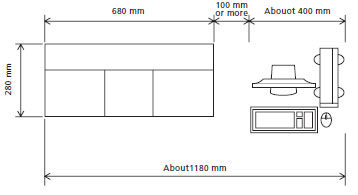
Measurement of 0.4 mL samples is possible
Disposable Cell
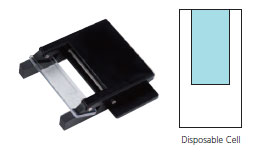
- High-concentration samples can be measured using the laser diffraction method.
- Measurement is possible by simply holding the high-concentration sample particles to be measured between two glass slides.
- Samples for which the particle size distribution would be changed by dilution can be measured in their original state, or with the minimum required level of dilution, and true images of the measurement object can be obtained.
- Commercial hand creams, face creams, and rinses can be measured with hardly any pretreatment.
Measurement Principle for High-Concentration Samples
If a standard flow cell or batch cell is used to measure a sample at a high concentration, the long light path length results in multiple scattering, making it impossible to obtain accurate measurements. Accurate measurement is possible by simply holding the high-concentration sample particles to be measured between two glass slides, which shortens the length of the light path and avoids the negative effects of multiple scattering.
Also, arranging the glass slides so that they are diagonal to the optical axis makes it possible to detect side scattered light. Applying particle size distribution calculations to this and to forward scattered and back scattered light enables high-concentration sample measurement for fine and ultrafine particles.

Aggregation evaluation with a stirring function is possible
Batch Cell [SALD-BC75]
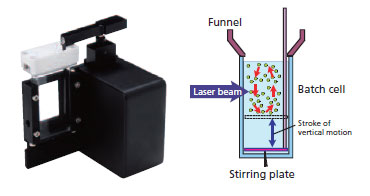
- Measurement is possible with small amounts of sample (i.e., measured particles) and liquid medium (i.e., dispersion medium).
- The capacity of the batch cell is only 5cm3 so waste treatment for the suspension can be performed with relatively small amounts.
- The vertical motions of the stirring plate prevent sedimentation of the particles.
- The funnel reduces the possibility of sample spillage.
- A tetrafluoroethylene resin funnel is provided to reduce the possibility of suspension getting on the hands of the user. It also prevents the cell surface from becoming dirty.
Aggregates Sizer Specifications
Measurement Assistant Function Allows Preparing an SOP to Ensure Measurements Are Always Performed Using the Same Conditions and Procedures
Creating, saving, and sharing measurement conditions and procedures, including pretreatment methods and conditions, ensures measurements are performed using the same conditions and procedures, even if performed by a different operator or at a different location or plant, and allows safely comparing data. Furthermore, when the measurement assistant function is used, instructions for the operator are displayed on the screen. This enables even inexperienced operators to perform measurements correctly.
In addition, administrators and operators can be assigned different operating privileges to ensure security.
Note: SOP is an acronym for Standard Operating Procedure.
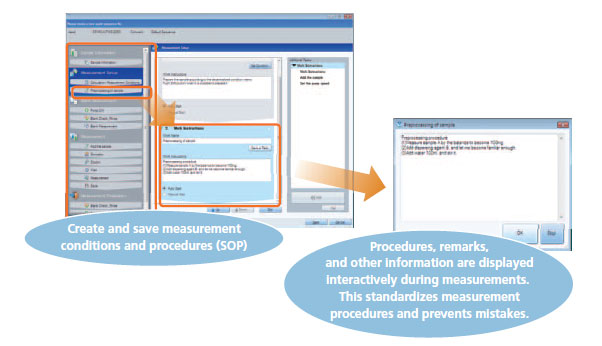
Monitors Changes in Sample Status in Real Time
Particle size distribution data and light intensity distribution data can be displayed in real time. This means that sample changes over time or shifts in the dispersion status can be monitored in real time. Since both the light intensity distribution data, which is the raw data, and particle size data can be monitored simultaneously, they can be compared to keep track of any changes in the status of samples.
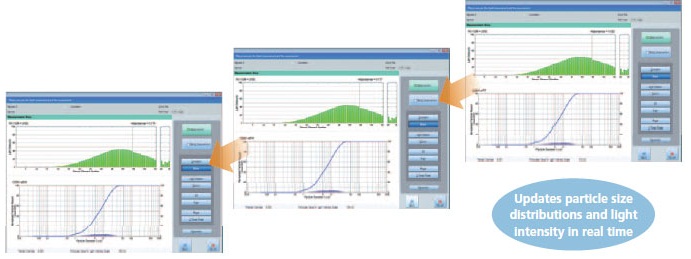
Seamless measurement over the entire range using a single measurement principle, single optical system, and single light source. The SLIT optical system continuously captures forward-scattered light at up to 60° on a single detection plane
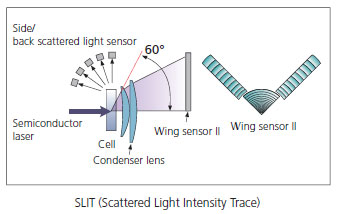
The target particle size range is covered using a single measurement principle, single optical system, and single light source to achieve a perfectly seamless single wide range. Accurate particle size distribution measurements are possible across the entire measurement range using a single standard, as the instrument does not incorporate multiple optical systems that create discontinuities in the data.
The application of the SLIT optical system, based on sophisticated scattered light intensity tracing technology, smashes conventional wisdom to continuously capture forward-scattered light at up to a wide 60° angle on a single-detector face. This achieves high resolution in the fine particle region.
More Stable Optical System
The Omnidirectional Shock Absorption Frame (OSAF) is employed to fully isolate all elements of the optical system from the disturbances of shocks and vibrations.
High-Resolution/High-Sensitivity Wing Sensor II
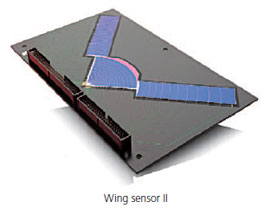
Forward diffracted/scattered light is detected by a “wing sensor II”, a 76-element sensor that was developed using semiconductor manufacturing technology of the highest level. This sensor can detect greatly fluctuating small-angle forward scattering with a high level of resolution and wide-angle scattering of low optical intensity with a high level of sensitivity. Also, side scattered light is detected by one sensor element and back scattered light is detected by four sensor elements. Accurately capturing light intensity distribution patterns with a total of 84 sensor elements enables the high-resolution, high-precision measurement of particle size distributions over a wide particle diameter range.
Self-Diagnostic Functions Ensure Easy Maintenance
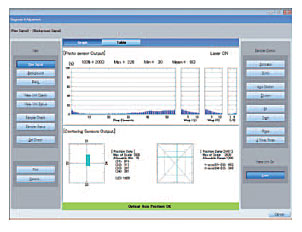
These analyzers incorporate powerful self-diagnostic functions. The output signals sent by the sensors and detecting elements, and the instrument operating status, can be checked, facilitating easier maintenance. Using the Operation Log function, detailed information about, for example, the instrument usage status and contamination of the cells is included with all the measurement data, making it possible to investigate the validity of measurement data obtained in the past.


